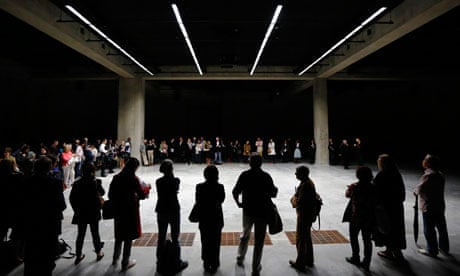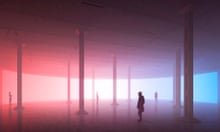On 18 July, the first phase of Tate Modern's new extension opens to the public. And, hopes Tate's director, Nicholas Serota, it will be more than a grand new architectural gesture. It should, he said, mark a new chapter in the way contemporary art is captured, studied and, most importantly, experienced by the public – something as significant for art in Britain as the opening of the Turbine Hall a dozen years ago.
The Tanks' purpose is to bring live work and performance art – often, since its origins in the 1960s and 70s, seen as too fragile, fugitive or plain avant garde to be co-opted by museums – into the mainstream. The underground galleries will also provide space for the kind of large, complex film and video installations that the museum has struggled to show in the past. Serota said the Tanks would provide "a new instrument in the orchestra that is Tate Modern".
He added: "It will bring the kind of work that has traditionally been seen in alternative spaces, for short durations, and often barely recorded, into the museum. It will bring it into our own sense of art history as something that is not on the margins, but something central to art."
Reading this on mobile? Click here to view video
The Tanks are the fruit of the first £90m spent on plans to enlarge the exhibition space of the already vast museum by 70%. The extension project, which is planned to cost £215m in total, is due for completion by 2016 – delayed from its previously projected opening of this year.
But the Tanks are the first significant step. Converted from vast chambers beneath the old Bankside Power Station which once held a million gallons of oil, the new public areas consist of two large circular spaces for performances and film installations, plus a warren of smaller rooms.
Converted by architects Herzog + de Meuron, also responsible for designing the first phase of Tate Modern, which opened in 2000, the new areas retain some of the roughness and grit of their former industrial purpose. With their raw-concrete feel, they have an atmosphere quite unlike the "white cube" galleries in the rest of the building, acknowledging that some of the most exciting art made over the past decade has been found not in antiseptic galleries but in abandoned warehouses, derelict buildings and other "found" spaces.
From 18 July, the Tanks will be the scene of a 15-week opening programme of live art, performance and installations, including dance by choreographer Anne Teresa De Keersmaeker, a film installation by young Korean artist Sung Hwan Kim, and performances by Eddie Peake. There will also be what Tate Modern director Chris Dercon calls "rediscoveries", including an installation recording a participatory feminist work made by Suzanne Lacy in the 1980s, about women's experience of ageing.
Though performances will halt during periods of intense building of the main part of the new extension, future plans include the hugely popular 24-hour film installation The Clock by artist Christian Marclay, which caught the imagination of audiences when it was shown at the Venice Biennale in 2011 and at White Cube in London.
Performance and live art is having its moment. For the first time, an artist (Spartacus Chetwynd) has been shortlisted for the Turner prize primarily because of performance work. The Anglo-German artist Tino Sehgal will unveil a participatory performance work in the Turbine Hall at Tate Modern next week. Veteran performance artists such as Marina Abramović are being newly recognised, with a documentary about her work out this month and a recent retrospective at the Museum of Modern Art, New York.
The desire for live encounters, by both artists and audiences, was partly a reaction to the economic and political climate, said Dercon. Artists and audiences were expressing a disillusion with the impersonal systems that dominate modern life, and reaching for the human encounter.
"I'm not going to talk about politicians and banks, but we are completely surrounded by systems that do things to us and at us. Performance proposes a new form of interconnectivity."
The desire to focus work without physical form, that cannot straightforwardly be bought and sold, may also express a wider dissatisfaction among the art world for the vagaries of the art market and the extreme commercialisation of art before the financial crash of 2008.
According to Catherine Wood, Tate's curator of contemporary art and performance, "there is a desire for community among artists, and a desire to get away from the dominant news story about art, which is 'Damien Hirst sells for £50m'".
Serota added: "At a time of austerity, people are rethinking their values and looking at art that doesn't straightforwardly have a market … Artists want to make work that engages directly with audiences and is not so susceptible to commercial development."
The Tate curators argued that nothing would be lost by bringing the history of performance art into the mainstream, away from its improvisatory, rough-and-ready origins in the avant garde. "It's no different from hanging Venetian altarpieces in the National Gallery," said Wood. "Art is often shown in very different contexts from those originally intended. In a museum, you can see things in the context of other works: that's what museums are for."
How successful the spaces are will be shown only when artists, and audiences, have reacted to them. Wood remembered the shock of the Tate Modern Turbine Hall – the completely unexpected and anarchic way in which visitors adopted works such as Olafur Eliasson's The Weather Project in 2003. "He and we had no idea that visitors would really claim that space," she said, recalling how people had basked in the artificial orange sun he had created, and watched themselves in the giant mirrors he installed on the ceiling. "People are going to play here too: how remains to be seen."
In the words of Stuart Comer, Tate's curator of film, the spaces are "tickets to the unknown".




Comments (…)
Sign in or create your Guardian account to join the discussion